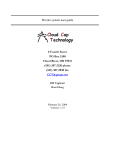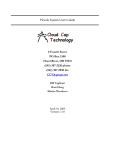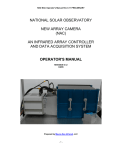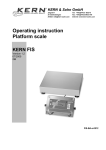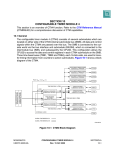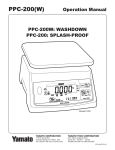Download Technology Cloud Cap - Unmanned Aircraft & Drones
Transcript
Piccolo Avionics External Interface Specification Cloud Cap Technology 8 Fourth Street PO Box 1500 Hood River, OR 97031 (541) 387-2120 phone (541) 387-2030 fax [email protected] www.uavautopilots.com Bill Vaglienti Ross Hoag Updated April 20, 2005 Cloud Cap Technology PO Box 1500, No 8 Fourth Street Hood River, OR 97031 (541) 387-2120 ph (541) 387-2030 fax Table of Contents 1 2 Vehicle Interface Connections ............................................................................................. 4 1.1 External I/O – Piccolo/Piccolo Plus/Piccolo II............................................................ 4 1.2 External I/O – Piccolo II............................................................................................... 5 1.3 UHF and GPS Antenna ................................................................................................ 5 1.4 Pitot and Static Pressure Ports .................................................................................... 6 Vehicle Interface Configurations......................................................................................... 6 2.1 3 4 Typical Configuration .................................................................................................. 6 Functional Descriptions........................................................................................................ 7 3.1 DC Inputs....................................................................................................................... 7 3.2 DC Outputs.................................................................................................................... 8 3.3 Serial I/O........................................................................................................................ 9 3.4 PWM Outputs ............................................................................................................... 9 3.5 Controller Area Network Interface............................................................................. 9 3.6 No Connects................................................................................................................... 9 Signal Descriptions.............................................................................................................. 10 4.1 Piccolo and Piccolo Plus ............................................................................................. 10 4.2 Piccolo II ...................................................................................................................... 12 Cloud Cap Technology PO Box 1500, No 8 Fourth Street Hood River, OR 97031 (541) 387-2120 ph (541) 387-2030 fax Figures Figure 1 – Piccolo/Piccolo Plus Front Panel................................................................................... 4 Figure 2. - Piccolo II Front Panel.................................................................................................... 5 Figure 3 - Typical Configuration .................................................................................................... 7 Figure 4 - Piccolo DC Inputs and Outputs...................................................................................... 8 Tables Table 1 P1 - External Interface Connector Pin Assignments ...................................................... 10 Table 2 P2 - Piccolo II MicroDot Connector Pin-out .................................................................. 12 Cloud Cap Technology PO Box 1500, No 8 Fourth Street Hood River, OR 97031 (541) 387-2120 ph (541) 387-2030 fax Piccolo External Interface 1 Vehicle Interface Connections 1.1 External I/O – Piccolo/Piccolo Plus/Piccolo II Piccolo, Piccolo Plus, and Piccolo II support a single 44-pin high-density filtered external interface connector (see Figure 1). The connector chosen, while not the smallest or highest density available, provides a cost-effective solution in a small footprint whose benefits includes: • • • • • Integral capacitive filtering for minimizing EMI; A robust “gorilla proof “ electro-mechanical vehicle interface; Readily available low-cost industry standard mating connectors; No special tooling required for mating wire harness fabrication; Provision for continuous shielding across the connector interface for enhanced EMI protection. Figure 1 – Piccolo/Piccolo Plus Front Panel All I/O pins are ESD protected at point of entry and the Maxim RS232 transceiver used provides enhanced on chip 15kV ESD protection for the two serial interfaces. The main DC input is reverse polarity as well as ESD protected. 1.1.1 Mating 44-pin connector specification Connector, D-Sub HD 44 HD-22 • • • CCT part number Digikey part number Amp part number Pins, 22-28 Awg HD-22 760-00330-00 A2078-ND 748366-1 Cloud Cap Technology • • • PO Box 1500, No 8 Fourth Street Hood River, OR 97031 (541) 387-2120 ph (541) 387-2030 fax CCT part number Digikey part number Amp part number 760-00329-00 A2088-ND 748333-4 1.2 External I/O – Piccolo II Piccolo II has a second external interface connector: a 25-pin Micro-D connector, that provides additional I/O, serial ports and analog inputs – see Figure 2. Figure 2. - Piccolo II Front Panel 1.2.1 Mating 25-pin connector specification (Piccolo II only) The mating connector is supplied with the Piccolo II. It comes with a 18” long pigtail which the user can mate to as needed. Note: It’s up to the user to properly terminate the unused as well as the used connections. Connector, 25 Position Socket Pigtail Harness • • CCT part number Glenair part number 760-00636-00 MWDM2L-25S-6K1-18B 1.3 UHF and GPS Antenna Additionally the Piccolo front panel has two SMA coaxial connectors which are used for the vehicle UHF and GPS antenna connections. It is recommended that low loss RG174 or RG316 cable be used for all external cabling. SMA connectors were chosen due to their availability, ease of use and robustness. 1.3.1 GPS antenna power for active antennas The default output voltage for active GPS antennas are outlined below. • Piccolo/Piccolo Plus – 3V Cloud Cap Technology • PO Box 1500, No 8 Fourth Street Hood River, OR 97031 (541) 387-2120 ph (541) 387-2030 fax Piccolo II – 5V Note: Piccolo or Piccolo Plus units can be alternately configured for 5V antenna power. Piccolo II is 5-volt output only. 1.4 Pitot and Static Pressure Ports Two pressure port fittings provide the interface to the vehicle pitot/static system. The fittings accept 3/32 ID tubing. We use Cole Parmer 3/32” ID, 5/32” OD, 1/16” wall lab grade Tygon tubing (part number 06408-63 type R-3603). 2 Vehicle Interface Configurations The mix of signals provided on the external interface connector support a multitude of different vehicle configurations. The most common configuration is outlined below but custom implementations that meet your specific interface requirements can also be accommodated. 2.1 Typical Configuration A typical configuration (see Figure 3) would include: 10 PWM outputs for driving control surfaces; two serial connections (four for Piccolo II); GPS and UHF antenna connections; Flight termination and or ignition connection; power inputs; and optional payloads attached via the CAN bus. The two serial links are used for payload and for long-range UHF data links (Piccolo II includes a dedicated Iridium serial port and a second payload port). Seven unassigned TPU lines are available (by retasking the control surface lines) for discrete timing, I/O, or PWM. A switched Deadman’s output is available that can be used for flight termination in the event of upstream hardware or software failure or as a general purpose On/Off switch for controlling payloads or other aircraft systems. Cloud Cap Technology PO Box 1500, No 8 Fourth Street Hood River, OR 97031 (541) 387-2120 ph (541) 387-2030 fax Up to 10 PWM outputs for servo s Over the Horizon Link 1 2 3 4 N Available on Piccolo II Only Serial 4 Dedicated Iridium Communications GPS Serial 3 User Payload 2 External Communications Program Port Short Range Link Data and Pilot Uplink Commands Serial 1 Piccolo Avionics Serial 2 User Payload Ignition or Flight Termination Hardware-in -Loop Simulator Interface Deadman's 8 - 20 VIN Battery or Generator Input CAN bus User Payloads User Payloads User Payloads Denotes Optional Component Figure 3 - Typical Configuration 3 Functional Descriptions 3.1 DC Inputs 3.1.1 Main VIN Piccolo, Piccolo Plus and Piccolo II were designed for a nominal DC input (VIN) of 12 volts with an operational input voltage range of 8-20 VDC (see Figure 4). 3.1.2 Servo Power Piccolo, Piccolo Plus and Piccolo II were designed for a nominal servo power input (SERVO_Vin_1) of 4.8 or 6.0 volts. This input was designed to accommodate typical RC hobby servos. Servo load current is limited to a maximum of 2-amps (limited by the 44-pin connector). If your servo load is expected to be greater than 2-amps and your Piccolo serial number is 555 or above a second servo power input (SERVO_Vin_2) is available. You can parallel the two input pins to double your servo load capacity (don’t forget to double the ground pins as well). If you have questions regarding this configuration please give us a call for further details. Note: Serial numbers prior to 555 do not support the second servo power input pin (SERVO_Vin_2) that pin is a No Connect (NC1). Cloud Cap Technology PO Box 1500, No 8 Fourth Street Hood River, OR 97031 (541) 387-2120 ph (541) 387-2030 fax x2 Servo Vin 1 Servo Vin 2 (4.8-6 Volts) Voltage and Current Measuremet Servo power pass through, 5-volts nominal x7 Servo Vout Deadman's Output x1 Deadman's Switch (44 Pin) External Interface Keep Alive Signal From MPC555 Schottky Diode 12VDC Main DC Input VIN (8-20) Volts Voltage and Current Measuremet Piccolo On-Board Regulators and Sub-Systems TVS Diode x12 GND All grounds are connected Figure 4 - Piccolo DC Inputs and Outputs 3.2 DC Outputs The interface connector provides seven unswitched (SERVO_Vout) and one switched (Deadman’s Output) DC outputs. 3.2.1 Servo DC Outputs These outputs are used to power the vehicle control surface actuators, typically RC model servos. The voltage on these outputs will track whatever voltage is applied to the SERVO_Vin pin(s) – the Piccolo acts as a pass through and in the process measures both the voltage and current of this user supplied voltage rail. 3.2.2 Deadman’s Output The Deadman’s switch consists of a power MOSFET driven by a watchdog timer circuit. The deadman’s switch requires that software periodically service a hardware line to keep the switch active. Hence if the system fails, either due to software or hardware failure, the Deadman’s switch turns off. This switch can be connected to an ignition system, or other flight termination system, and so provides a measure of safety in the event that the system fails. Please refer to the “Piccolo User’s Manual” for further details on how to setup and use the Deadman’s output. The MOSFET switch can drive up to a 3-amp load and is powered from SERVO_Vin. When activated (turned on) it will provide a voltage level of SERVO_Vout (4.8-6.0 volts nominal), when deactivated (turned off) it will float the output – disconnect the load. Cloud Cap Technology PO Box 1500, No 8 Fourth Street Hood River, OR 97031 (541) 387-2120 ph (541) 387-2030 fax 3.3 Serial I/O The Piccolo Plus external interface connector supports two dedicated RS232 universal asynchronous receiver transmitter (UART) serial ports; one for programming and/or general serial I/O (115K baud max); and the other for general serial I/O or payload communications (56K baud max). Note: any of the other TPU lines or PWM, if unused, can also be configured for use as GPIO, timing I/O or as PWM outputs. In addition Piccolo II, which has an additional external interface connector, provides a dedicated 4-wire RS232 port for connection to an Iridium satellite terminal as well as and a second payload serial port. 3.4 PWM Outputs The interface connector offers the option to directly drive up to 10 standard RC servos providing PWM outputs, powers and grounds for each. The PWM outputs are divided into two banks: • • Bank 1 - PWMSM[0-4] are nominally PWM outputs used for servos 1-5. The can also be configured for GPIO or timing output Bank 2 - TPU_A[0-4] are nominally PWM outputs sued for servos 6-10. They can also be configured for GPIO, or timing input and output. 3.5 Controller Area Network Interface A Controller Area Network (CAN) serial interface is also provided for bussed or multi-drop applications. The CAN bus is a robust two wire differential serial bus designed for use in high EMI environments. It has seen wide use in automotive and industrial control applications and should prove to be well suited for UAV applications. The CAN bus is also used to provide the link between the Piccolo avionics and the Piccolo hardware in the loop simulator1. Follow on products will include a number of payload modules that will connect using this interface. We envision a 5-wire interface CANH, CANL, V1, V2, GND plus an overall shield. Nominally V1 and V2 would be 5V and 12V respectively. Piccolo II provides access to a second CAN bus on its additional interface connector. Functionality is TBD – added for custom applications. 3.6 No Connects If you have a Piccolo or Piccolo plus prior to serial number 555 you have access to two no connects (NC1 and NC2) which if needed can be used for custom applications – call CCT for further details if you need to use them. If you have a Piccolo Plus or Piccolo II serial number 555 or above, these pins are configured as secondary servo power inputs (SERVO_Vin_2 and GND). This was added to provide for operating with larger servo loads (current loads above 2-amps) . See section 3.1.2 for further details. 1 Hardware in loop simulation is arguably one of the most important features of any UAV development system. Cloud Cap Technology PO Box 1500, No 8 Fourth Street Hood River, OR 97031 (541) 387-2120 ph (541) 387-2030 fax 4 Signal Descriptions 4.1 Piccolo and Piccolo Plus Table 1 P1 - External Interface Connector Pin Assignments TYPE O O O O PWR/GND CAN SERIAL COMMS O I I I Program/User Mode Control Input - MPIO32B5 Hardware Reset - actve low Ground RS232 Ext Com/Program Port TX RS232 Ext Com/Program Port RX Before serial number 555, this is a no-connect Main DC Input - 5.5-20 Vin SPARE I/O O O I/O I/O I/O I/O I/O O O I O 5 5V 5V O O 4 I I O O 3 I/O I/O 0 I I/O I/O LEVEL FUNCTION Gnd for servo 1 ! Power for servo 1 Servo 1 signal output - Left Aileron 5V Gnd for servo 2 ! Power for servo 2 Servo 2 signal output - Left Elevator 5V Gnd for servo 3 ! Power for servo 3 Servo 3 signal output - Left Throttle 5V Gnd for servo 4 ! Power for servo 4 Servo 4 signal output - Left Rudder 5V Gnd for servo 5 ! Power for servo 5 Servo 5 signal output - Left Flap 5V 5V Servo 6 signal output - Right Aileron 5V Servo 7 signal output - Right Elevator 5V Servo 8 signal output - Right Throttle 5V Servo 9 signal output - Right Rudder Servo 10 signal output - Right Flap 5V ! ! Servo power input 4.8-6V nominal Servo power switched by deadman circuit Ground Ground Ground CAN Ground CAN CAN A Serial High CAN CAN A Serial Low 232 Payload 1 TX -User RS232 Output - TPU_B[0] 232 Payload 1 RX - User RS232 Input - TPU_B[1] 5V User Configurable I/O 5V User Configurable I/O 2 NAME GND SERVO_Vout PWMSM[0] GND SERVO_Vout PWMSM[1] GND SERVO_Vout PWMSM[2] GND SERVO_Vout PWMSM[3] GND SERVO_Vout PWMSM[4] TPU_A[0] TPU_A[1] TPU_A[2] TPU_A[3] TPU_A[4] SERVO_Vout SERVO_Vout SERVO_Vin_1 Deadman's output GND GND GND CAN_GND CAN_HI_A CAN_L0_A TXD_RS232 RXD_RS232 TPU_B[2] TPU_B[3] GND *PROGRAM/USER *HRESET GND SCI_2_TX_232 SCI_2_RX_232 SERVO_Vin_2 / NC1 VIN GND SERVO_GND / NC2 1 PIN 15 30 44 14 29 43 13 28 42 12 27 41 11 26 40 39 38 37 36 35 25 24 23 6 10 9 8 7 22 21 34 33 5 20 4 19 18 3 32 31 16 1 2 17 Before serial number 555, this is a no connect PWMSM[0-4] (0-5 volt output) In the default mode these are configured as PWM outputs and are used to control the actuators on left side of the airplane. SERVO_Vin_1 (4.8-6.0 volt input) User supplied input voltage used to power the servos Cloud Cap Technology PO Box 1500, No 8 Fourth Street Hood River, OR 97031 (541) 387-2120 ph (541) 387-2030 fax SERVO_Vout (output) DC output whose voltage matches the applied SERVO_Vin inputs. Nominally these are used as servo power pins. Deadman's output (output) Switched DC output whose output voltage matches the applied SERVO_Vin_1 input DC voltage. ON/OFF controlled via software by an onboard Deadman’s circuit. Typically used for ON/OFF control of an ignition or flight termination system. TPU_A[0-4] (0-5 volt input/output) In the default mode these are configured as PWM outputs and are used to control the right side of the airplane. They can be independently configured for GPIO, TTL level serial communications, or timing if not needed for actuator control. TPU_B[2-3] (0-5 volt input/output) In the default mode these are configured as RPM inputs for a left and right engine respectively. They can also be independently configured for GPIO, TTL level serial communications, or timing. CAN_HI_A - (CAN level I/O) CAN_LO_A - (CAN level I/O) CAN_GND - Same as system ground (GND). TXD_RS232 (RS232 output) Driven by TPU B CH0 on the MPC555 – Payload 1 transmitter. RXD_RS232 (RS232 input) Received by TPU B CH1 on the MPC555 – Payload 1 receiver. *PROGRAM/USER (0-3.3 volt input) When held low during a reset the MPC555 boots in monitor mode from which application code can be loaded to flash; When left floating or driven high during a reset causes the MPC555 to boot and run user application code. The pin has a 10k pull-up to 3.3 volts. *HRESET (0-3.3 volt input) When pulled low forces the MPC555 into a hard reset. The pin has a 10k pull-up to 3.3 volts. SCI_2_TX_232 (RS232 level output) Driven by SCI CH2 TX on the MPC555. Each SCI is a full-duplex universal asynchronous receiver transmitter (UART) serial interface. External communications/Programming serial transmitter. SCI_2_RX_232 (RS232 level input) Received by SCI CH2 RX on the MPC555. Each SCI is a full-duplex universal asynchronous receiver transmitter (UART) serial interface. External communications/Programming serial receiver. NC[1-2] (User defined) User defined no connect pins for future applications on Piccolo and Piccolo Plus serial numbers below 555. On Piccolo Plus and Piccolo II’s serial numbers 555 and above NC1 and NC2 are configured as secondary inputs for servo power, SERVO_Vin_2 and SERVO_GND respectively. VIN (8-20 volt input) DC input voltage used to power the onboard 5.5-volt and 3.3-volt switching regulators. Cloud Cap Technology PO Box 1500, No 8 Fourth Street Hood River, OR 97031 (541) 387-2120 ph (541) 387-2030 fax GND Common ground tied to the internal ground plane of the avionics and the shell of the main interface connector. 4.2 Piccolo II Table 2 P2 - Piccolo II MicroDot Connector Pin-out PIN 24 13 12 11 10 9 22 23 21 19 17 15 8 18 20 7 6 16 5 4 14 3 2 1 25 NAME CAN_LO_B CAN_HI_B AIN0 AIN1 AIN2 AIN3 AGND AGND TPU_B8 TPU_B9 TPU_B10 TPU_B11 GND GND GND TXD1_232 RXD1_232 GND TXD2_232 RXD2_232 GND TXD3_232 RXD3_232 GND No Connection TYPE I/O I/O I I I I LEVEL CAN CAN 5V 5V 5V 5V I/O I/O I/O I/O 5V 5V 5V 5V O I RS232 RS232 O I RS232 RS232 O I RS232 RS232 FUNCTION Serial TX/RX Serial TX/RX 10 bit anlog input 10 bit anlog input 10 bit anlog input 10 bit analog input Analog ground Analog ground GPIO3 GPIO4 GPIO5 GPIO6 Ground Ground Ground Iridium TXD Iridium RXD Ground Iridium DTR Iridium CD Ground Payload 2 RS-232 Tx Payload 2 RS-232 Rx Ground CAN_HI_B (CAN level I/O) CAN_LO_B (CAN level I/O) AIN[0-4] (0-5 volt inputs) User configurable 10-bit analog inputs. Each input has a 100pF capacitor to ground and a 1k ohm series resistor. See the “Piccolo User’s Guide” for further details on configuration and use. AGND – Returns for the four analog inputs. TPU B[8-11] (0-5 volt I/O) Can also be independently configured for GPIO, or timing. GND – Returns for any of the digital I/O. TXD1 (RS232 output) Iridium transmit data. RXD1 (RS232 input) Iridium receive data. TXD2 (RS232 output) Data Terminal Ready (DTR) output to Iridium unit. RXD2 (RS232 input) Carrier Detect (CD) from Iridium unit. TXD3 (RS232 output) Payload 2 transmit data. RXD3 (RS232 input) Payload 2 receive data.












